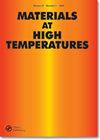Corrosion of Potential First Stage Blade Materials in Simulated Supercritical CO2
IF 0.9
4区 材料科学
Q4 MATERIALS SCIENCE, MULTIDISCIPLINARY
引用次数: 0
Abstract
ABSTRACT Global power consumption is predicted to double by 2050, notably driven by the transportation and energy sectors necessitating limitations of emissions. Due to its compact turbomachinery, better thermal efficiency, and simpler layout, supercritical-CO2 cycles have received attention, with numerous variations proposed (either indirect-fired/closed cycles or direct-fired-open cycles). One technical challenge is degradation pathway quantification of turbine materials in sCO2 as selection is crucial to successfully and economically operate new plants. This requires degradation assessment in representative environments simulating the Allam cycle. Laboratory tests were conducted on a first stage turbine blade alloy, CM247, with either an environmentally resistant coating or bond coat/thermal barrier coat at one atmosphere and 800°C, with potential exposure including (O2, H2O, N2, SO2) for up to 1000 h. Weight change and metallographic measurements tracked scale development. Scanning electron microscopy/energy dispersive X-ray spectroscopy studied scales and internal precipitates. Locations of contaminant element in the CO2-rich environment were investigated.潜在第一级叶片材料在模拟超临界CO2中的腐蚀
预计到2050年,全球电力消耗将翻一番,主要是由于交通和能源部门需要限制排放。由于其紧凑的涡轮机械,更好的热效率和更简单的布局,超临界二氧化碳循环受到了关注,提出了许多变化(间接燃烧/封闭循环或直接燃烧-开放循环)。一个技术挑战是涡轮材料在sCO2中的降解途径量化,因为选择对成功和经济地运行新工厂至关重要。这需要在模拟阿拉姆循环的典型环境中进行退化评估。在一个大气压和800°C的条件下,对具有环境抗性涂层或粘结涂层/热障涂层的第一级涡轮叶片合金CM247进行了实验室测试,潜在暴露包括(O2, H2O, N2, SO2)长达1000小时。重量变化和金相测量跟踪了水垢的发展。扫描电子显微镜/能量色散x射线光谱学研究了鳞片和内部沉淀。研究了富co2环境中污染物元素的位置。
本文章由计算机程序翻译,如有差异,请以英文原文为准。
求助全文
约1分钟内获得全文
求助全文
来源期刊

Materials at High Temperatures
工程技术-材料科学:综合
CiteScore
1.90
自引率
15.40%
发文量
58
审稿时长
>12 weeks
期刊介绍:
Materials at High Temperatures welcomes contributions relating to high temperature applications in the energy generation, aerospace, chemical and process industries. The effects of high temperatures and extreme environments on the corrosion and oxidation, fatigue, creep, strength and wear of metallic alloys, ceramics, intermetallics, and refractory and composite materials relative to these industries are covered.
Papers on the modelling of behaviour and life prediction are also welcome, provided these are validated by experimental data and explicitly linked to actual or potential applications. Contributions addressing the needs of designers and engineers (e.g. standards and codes of practice) relative to the areas of interest of this journal also fall within the scope. The term ''high temperatures'' refers to the subsequent temperatures of application and not, for example, to those of processing itself.
Materials at High Temperatures publishes regular thematic issues on topics of current interest. Proposals for issues are welcomed; please contact one of the Editors with details.
 求助内容:
求助内容: 应助结果提醒方式:
应助结果提醒方式:


